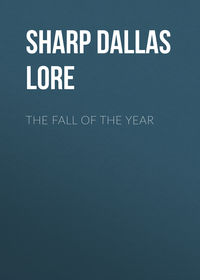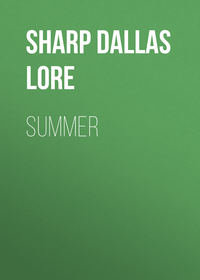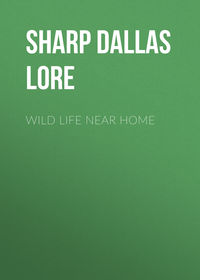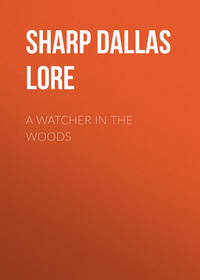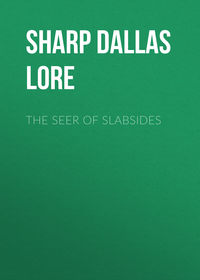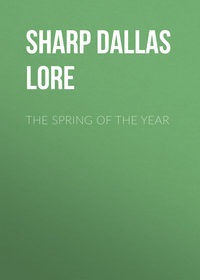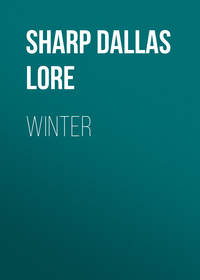 полная версия
полная версияThe Lay of the Land
At the sign of the shad-bush how swiftly the tides of life rise! how mysteriously their currents run! drifting, flying, flowing, creeping – colors, perfumes, forms, and voices – across the heavens, over the earth, and down the deep, dim aisles of the sea! and down the deep, dim aisles of our memories.
VIII
The Nature Movement
I was hurrying across Boston Common. Two or three hundred others were hurrying with me. But ahead, at the union of several paths, was a crowd, standing still. I kept hurrying on, not to join the crowd, but simply to keep up the hurry. The crowd was not standing still, it was a-hurrying, too, scattering as fast as it gathered, and as it scattered I noticed that it wore a smile. I hastened up, pushed in, as I had done a score of times on the Common, and got my glimpse of the show. It was not a Mormon preaching, not a single-taxer, not a dog fight. It was Billy, a gray squirrel, taking peanuts out of a bootblack’s pocket. And every age, sex, sort, and condition of Bostonian came around to watch the little beast shuck the nuts and bury them singly in the grass of the Common.
“Ain’t he a cute little cuss, mister?” said the boy of the brush, feeling the bottom of his empty pocket, and looking up into the prosperous face of Calumet and Hecla at his side. C. and H. smiled, slipped something into the boy’s hand with which to buy another pocketful of peanuts for Billy, and hurried down to State Street.
This crowd on the Common is nothing exceptional. It happens every day, and everywhere, the wide country over. We are all stopping to watch, to feed, and – to smile. The longest, most far-reaching pause in our hurrying American life to-day is this halt to look at the out-of-doors, this attempt to share its life; and nothing more significant is being added to our American character than the resulting thoughtfulness, sympathy, and simplicity, – the smile on the faces of the crowd hurrying over the Common.
Whether one will or not, he is caught up by this nature movement and set adrift in the fields. It may, indeed, be “adrift” for him until he gets thankfully back to the city. “It was a raw November day,” wrote one of these new nature students, who happened also to be a college student, “and we went for our usual Saturday’s birding into the woods. The chestnuts were ripe, and we gathered a peck between us. On our way home, we discovered a small bird perched upon a cedar tree with a worm in its beak. It was a hummingbird, and after a little searching we found its tiny nest close up against the trunk of the cedar, full of tiny nestlings just ready to fly.”
This is what they find, many of these who are caught up by the movement toward the fields; but not all of them. A little five-year-old from the village came out to see me recently, and while playing in the orchard she brought me five flowers, called them by their right names, and told me how they grew. Down in the loneliest marshes of Delaware Bay I know a lighthouse keeper and his solitary neighbor, a farmer: both have been touched by this nature spirit; both are interested, informed, and observant. The farmer there, on the old Zane’s Place, is no man of books, like the rector of Selborne, but he is a man of birds and beasts, of limitless marsh and bay and sky, of everlasting silence and wideness and largeness and eternal solitude. He could write a Natural History of the Maurice River Marshes.
These are not rare cases. The nature books, the nature magazines, the nature teachers, are directing us all to the out-of-doors. I subscribe to a farm journal (club rates, twenty-five cents a year!) in which an entire page is devoted to “nature studies,” while the whole paper is remarkably fresh and odorous of the real fields. In the city, on my way to and from the station, I pass three large bookstores, and from March until July each of these shops has a big window given over almost continuously to “nature books.” I have before me from one of these shops a little catalogue of nature books – “a select list” – for 1907, containing 233 titles, varying in kind all the way from “The Tramp’s Handbook” to one (to a dozen) on the very stable subject of “The Farmstead.” These are all distinctively “nature books,” books with an appeal to sentiment as well as to sense, and very unlike the earlier desiccated, unimaginative treatises.
There are a multitude of other signs that show as clearly as the nature books how full and strong is this tide that sets toward the open fields and woods. There are as many and as good evidences, too, of the genuineness of this interest in the out-of-doors. It may be a fad just now to adopt abandoned farms, to attend parlor lectures on birds, and to possess a how-to-know library. It is pathetic to see “nature study” taught by schoolma’ams who never did and who never will climb a rail fence; it is sad, to speak softly, to have the makers of certain animal books preface the stories with a declaration of their absolute truth; it is passing sad that the unnatural natural history, the impossible out-of-doors, of some of the recent nature books, should have been created. But fibs and failures and impossibilities aside, there still remains the thing itself, – the widespread turning to nature, and the deep, vital need to turn.
The note of sincerity is clear, however, in most of our nature writers; the faith is real in most of our nature teachers; and the love, – who can doubt the love of the tens of thousands of those whose feet feel the earth nowadays, whose lives share in the existence of some pond or wood or field? And who can doubt the rest, the health, the sanity, and the satisfaction that these get from the companionship of their field or wood or pond?
There is no way of accounting for the movement that reflects in the least upon its reality and genuineness. It may be only the appropriation by the common people of the world that the scientists have discovered to us; it may be a popular reaction against the conventionality of the eighteenth century; or the result of our growing wealth and leisure; or a fashion set by Thoreau and Burroughs, – one or all of these may account for its origin; but nothing can explain the movement away, or hinder us from being borne by it out, at least a little way, under the open of heaven, to the great good of body and soul.
Among the cultural influences of our times that have developed the proportions of a movement, this so-called nature movement is peculiarly American. No such general, widespread turning to the out-of-doors is seen anywhere else; no other such body of nature literature as ours; no other people so close to nature in sympathy and understanding, because there is no other people of the same degree of culture living so close to the real, wild out-of-doors.
The extraordinary interest in the out-of-doors is not altogether a recent acquirement. We inherited it. Nature study is an American habit. What else had the pioneers and colonists to study but the out-of-doors? and what else was half as wonderful? They came from an old urban world into this new country world, where all was strange, unnamed, and unexplored. Their chief business was observing nature, not as dull savages, nor as children born to a dead familiarity with their surroundings, but as interested men and women, with a need and a desire to know. Their coming was the real beginning of our nature movement; their observing has developed into our nature study habit.
Our nature literature also began with them. There is scarcely a journal, a diary, or a set of letters of this early time in which we do not find that careful seeing, and often that imaginative interpretation, so characteristic of the present day. Even the modern animal romancer is represented among these early writers in John Josselyn and his delicious book, “New England’s Rarities Discovered.”
It was not until the time of Emerson and Bryant and Thoreau, however, that our interest in nature became general and grew into something deeper than mere curiosity. There had been naturalists such as Audubon (he was a poet, also), but they went off into the deep woods alone. They were after new facts, new species. Emerson and Bryant and Thoreau went into the woods, too, but not for facts, nor did they go far, and they invited us to go along. We went, because they got no farther than the back-pasture fence. It was not to the woods they took us, but to nature; not a-hunting after new species in the name of science, but for new inspirations, new estimates of life, new health for mind and spirit.
But we were slow to get as far even as their back-pasture fence, slow to find nature in the fields and woods. It was fifty years ago that Emerson tried to take us to nature; but fifty years ago, how few there were who could make sense out of his invitation, to say nothing of accepting it! And of Thoreau’s first nature book, “A Week on the Concord and Merrimack Rivers,” there were sold, in four years after publication, two hundred and twenty copies. But two hundred and twenty of such books at work in the mind of the country could leaven, in time, a big lump of it. And they did. The out-of-doors, our attitude toward it, and our literature about it have never been the same since.
Even yet, however, it is the few only who respond to Thoreau, Emerson, and Burroughs, who can find nature, as well as birds and trees, who can think and feel as well as wonder and look. Before we can think and feel we must get over our wondering, and we must get entirely used to looking. This we are slowly doing, – slowly, I say, for it is the monstrous, the marvelous, the unreal that most of us still go out into the wilderness for to see, – bears and wolves, foxes, eagles, orioles, salmon, mustangs, porcupines of extraordinary parts and powers.
There came to my desk, tied up with the same string, not long since, three nature books of a sort to make Thoreau turn over in his grave, – accounts of beasts and birds such as old Thetbaldus gave us in his “Physiologus,” that pious and marvelous bestiary of the dark ages. These three volumes that I refer to are modern and about American animals, but they, too, might have been written during the dark ages. All three have the same solemn preface, declaring the absolute truth of the observations that follow (as if we might doubt?), and piously pointing out their high moral purpose; all three likewise start out with the same wonderful story, – an animal biography: one, of a slum cat, born in a cracker box. Among the kittens of the cracker box was an extraordinary kitten of “pronounced color,” who survives and comes to glory. The next book tells the biography of a fox, born in a hole among the Canadian hills. Among the pups born in this hole was one extraordinary pup “more finely colored” than the others, who survives and comes to glory. The third book tells the biography of a wolf, born in a cave among the rocks, still farther north. Among the cubs born in this cave was one extraordinary cub, “larger than the others,” who survives and, as is to be expected of a wolf, comes to more glory than the cracker-box kitten or the fox pup of the hills.
Such are the stories that are made into texts and readers for our public schools; such are the animals that go roaming through the woods of the American child’s imagination. But no such kittens or cubs or pups lurk in my eight-acre woodlot. I have seen several (six, to be exact) fox pups, but never did I see this overworked, extraordinary, cum laude pup of the recent nature books.
So long as we continue to read and believe such accounts, just so long shall we find it impossible to go with Audubon and Thoreau and Burroughs, for they have no place to take us, nothing to show us when we arrive. Their real world does not exist.
But we know that a real, ordinary, yet a marvelous world does exist, and right at hand. The present great nature movement is an outgoing to discover it, – its trees, birds, flowers, its myriad forms. This is the meaning of the countless manuals, the “how-to-know” books, and the nature study of the public schools. And this desire to know Nature is the reasonable, natural preparation for the deeper insight that leads to communion with her, – a desire to be traced more directly to Agassiz, and the hosts of teachers he inspired, perhaps, than to the poet-essayists like Emerson and Thoreau and Burroughs.
Let us learn to see and name first. The inexperienced, the unknowing, the unthinking, cannot love. One must live until tired, and think until baffled, before he can know his need of Nature; and then he will not know how to approach her unless already acquainted. To expect anything more than curiosity and animal delight in a child is foolish, and the attempt to teach him anything more at first than to know the out-of-doors is equally foolish. Poets are born, but not until they are old.
But if one got no farther than his how-to-know book would lead him, he still would get into the fields, – the best place for him this side of heaven, – he would get ozone for his lungs, red blood, sound sleep, and health. As a nation, we had just begun to get away from the farm and out of touch with the soil. The nature movement is sending us back in time. A new wave of physical soundness is to roll in upon us as the result, accompanied with a newness of mind and of morals.
For, next to bodily health, the influence of the fields makes for the health of the spirit. It is easier to be good in a good body and an environment of largeness, beauty, and peace, – easier here than anywhere else to be sane, sincere, and “in little thyng have suffisaunce.” If it means anything to think upon whatsoever things are good and lovely, then it means much to own a how-to-know book and to make use of it.
This is hardly more than a beginning, however, merely satisfying an instinct of the mind. It is good if done afield, even though such classifying of the out-of-doors is only scraping an acquaintance with nature. The best good, the deep healing, come when one, no longer a stranger, breaks away from his getting and spending, from his thinking with men, and camps under the open sky, where he knows without thinking, and worships without priest or chant or prayer.
The world’s work must be done, and only a small part of it can be done in the woods and fields. The merchants may not all turn ploughmen and wood-choppers. Nor is it necessary. What we need to do, and are learning to do, is to go to nature for our rest and health and recreation.
IX
June
A reference to one of my notebooks shows that in June, 1895, there were thirty-six species of birds nesting within singing distance of my study windows; in 1907 there were thirty-two, the most distant nest being less than five minutes’ walk from my door.
This is not a modern natural history story, – an extraordinary discovery that only I am capable of making. Start your own June list, and I warrant you will find as many. For there is nothing peculiarly birdy about my small farm. Any place as uncongenial to English sparrows and one that offers a fair chance to the native birds will keep you busy counting nests in June.
In the chimney built the swifts (three or four families of them); in the barn loft a small colony of barn swallows; and under the roof of the pig-pen a pair of phœbes, my earliest spring birds and often the latest with a brood.
A bushy hillside drops from the porch to the old orchard, and along this steep southern slope nested a pair of indigo buntings and a pair of rose-breasted grosbeaks (my rarest neighbors); also, here in the thick underbrush were found chewinks, thrashers, black and white warblers, song sparrows, and a pair of partridges.
In the orchard there were half a dozen chippies’ nests, even more robins’, two nests of bluebirds, and one each of the tree swallow, flicker, yellow warbler, chebec, downy woodpecker, kingbird, great crested flycatcher, redstart, and screech owl.
Baltimore orioles nested in the elms along the road; close to the little river were the nests of catbirds and red-winged blackbirds; a nest of swamp sparrows and of Maryland yellow-throats in the meadow, and in the woodlot a pewee’s nest, a crow’s nest, and three nests of ovenbirds.
All these I found; but besides these I know that a pair of yellow-billed cuckoos built somewhere near the house, as did a pair of blue jays, wood thrushes, and chestnut-sided warblers. These I am still waiting for. I need another June.
Not one of all these birds is rare or even shy, unless it be the swamp sparrow; none of them that the veriest beginner should not come to know in the course of one June. For these are almost domesticated, our near neighbors and friends, who desire and who will return our friendly, neighborly calls.
There are other birds, like the hawks, the owls, the herons, the rarer thrushes, sparrows, warblers, and marsh birds, that require time and tramping for their discovery. I know the very log in which I could find young turkey buzzards in June; the clump of dog-roses where a least bittern will build; the old gum that for years has harbored a pair of barred owls; the little cove where, spring after spring, a black duck nests. But I should need a vacation to visit these.
I watch the others between times, – between five o’clock in the morning and breakfast, between breakfast and train time and church time, and on Saturdays to and from the garden. If you are your own gardener, you can carry not only a hoe, but along with it a pair of field glasses. I even combine the care of my pig and the study of the phœbes that share his pen. Occasionally I drop everything and hunt for a nest, as if life depended upon my finding it. But life doesn’t, the more’s the pity, for me. Life depends on the finding of things that are very different from birds’ nests, things that require a deal of hunting the whole year around. Yet I take the time to hunt birds’ nests, too, for life is more than meat (I raise a good many vegetables), and, after all, my life does depend, in no small measure, upon my finding a few birds’ nests in June.
I remember a June when I tried to get life out of a grocery store, and the sickness of it comes over me even yet at times. I sold kerosene oil, brown sugar, coffee, salt mackerel, and plug tobacco. I breathed the mingled breath of kerosene oil, brown sugar, coffee, salt mackerel, and plug tobacco, – the odor of mere money, – when I knew the fox grapes were in blossom, the magnolias and the azaleas; when I knew the fields were green and the birds were in song! I have longed for many things, but never as I longed that June for the farm, for the long, long day, yes, and for the long, long row. It was that kerosened, salt-mackereled, plug-tobaccoed – moneyed – June that took me back to sweet poverty and the farm.
I do not wish to think of living where the birds and wild flowers do not live with me. A city flat is convenient, and city life is exciting; but convenience and excitement plus meat and raiment are not the sum of life; neither, on the other hand, are pure air, sunshine, birds, flowers, a garden, quiet, and time to think, the whole of life. No; but when you consider the matter, there appears very little still needing to make life whole that you cannot have along with your birds, thoughts, and garden.
Whether you love the country or not, whether you know the difference between a kingbird and a kingcrab or not, you owe it to your body and your soul to get out into the open fields in June, – not to collect bird skins or birds’ eggs or to make a herbarium or a nature diary, but to live a while where the birds and flowers live. The city may be heaven enough for you all the rest of the year; but God didn’t make the city. There are seasons – March and February, usually – when it seems as if some one else has a hand in making the country. In June, however, the country is all and more than the poets say, – if it is poetry that you come out into the country for to feel.
Take my meadow, for instance, all aglow in June with buttercups, as if spread with a sheet of beaten gold! But now, if it is only hay that I am after (alas, too often it is), then my gold turns all to brass, and worse than brass, for buttercups, as my dairyman neighbor tells me, make the poorest kind of hay. I should keep no cow, perhaps. She gives nice milk, to be sure, but she eats up my beaten gold, she kills my buttercup poetry. Maybe I am too rich, I own too much: one cow, one horse, two pigs, thirty hens, fourteen acres of hills and trees. For it is the truth that I do not enjoy the foxes now as I did before I kept hens, nor the buttercups as I did before I got the cow. Suppose, now, besides all of this, I had money, – a lot of it! – several thousand dollars! You never get money along with a farm, and that is one reason why a farm is such a safe and sure investment for the soul. It is not the cow nor the chores, but money in or out of the bank, that robs life of its June.
Nor is owning one cow like having a dairy farm. The average man had better keep his money in the bank than invest in more than one cow. A single cow cannot eat all the gold out of one’s meadow. I am still glad for the buttercups; and where the meadow passes into the upland, where the buttercups give place to the daisies, my gold runs into silver; which means certainly that I am not making the farm pay, for on a paying farm a daisy – weed that it is, and not a native weed at that – is more like a spot of leprosy than of silver. Our daisies are not even those sung by the poets, I understand. What of it? A ten-acre field of them lies snow-white in my memory, fresh with the freshness of early June and the sweeter freshness of boyhood. And as for poetry, I have my own for them, – the poetry of boyhood, of Commencement days at the Institute, and of girls in white frocks.
There is no particular flower that means June to me as the hepatica means March, the arbutus April, the shad-bush May, and the red wood-lily July. I cannot think of single blossoms, or of here and there a spot of rare flowers, in June, but only of pastures drifted white, meadows purple-misted, and rolling hillsides billowy pink, – of laurel, forget-me-nots, daisies, viburnums, and buttercups. This is no time to botanize. Leave the collecting can at home, for one day at least, and wander forth, not to hunt, but to drift and float, or, if you run aground, to wade knee-deep in June. A botanist who is never poet misses as much in the out-of-doors as the poet who is never botanist.
If there were no other flower in the month but the white water-lily, June would still be June. “Who can contemplate it,” exclaims Mr. Burroughs, “as it opens in the morning sun, and distills such perfume, such purity, such snow of petal, and such gold of anther, from the dark water and still darker ooze! How feminine it seems beside its coarser and more robust congeners, how shy, how pliant, how fine in texture and starlike in form!”
How the water-lily and spatter-dock can grow from the same mud is past understanding. One has every grace, the other none. But the dock can live in stagnant water, which perhaps is a sort of compensation.
And these two, for me, are always associated with magnolias, —Magnolia glauca, – and magnolias are associated with “old, forgotten, far-off things.” Their absence from my swamps here is part of the price I pay for my transplanting to these New England fields.
If that were all, it were price enough. But think of June in New Jersey, with buzzards soaring, cardinals whistling, and turtle doves cooing; with swamps magnolia-scented, and woods astir with box-turtles, pine snakes, pine-tree lizards, and ’possums! Then think of June in Massachusetts with none of these, – at least in my neighborhood!
What then? I could scarcely strain the magnolia’s breath from the mingling odors if it were here, for the common air I breathe is the breath of blossoming clover, wild grape, elder, blackberry, rose, and azalea. I must almost smell them by families. For here are six wild roses perfuming my air, five viburnums, six dogwoods (these last quite lacking in perfume, be it said), and wild blackberries that I have never dared to number. Who wants to number them? to spend his June with a “plant analysis,” dissecting and keeping tally? It is enough now to be alive and out of doors among the flowers. Nor is it all of June to find thirty-six species of birds nesting within a radius of five hundred and fifty-five and one half feet from your front door. I do not cite these figures in order to startle, but to suggest, if I might, the joyous medley of life in June, its variety and abundance. You may not be able to name all the warblers; you have never yet made out which is which among the dogwoods and viburnums; the dogwood flowers are all four-pointed stars, while the viburnums are all five-pointed. But what of it, – four or five, dogwood or viburnum! Here they are, banked in soft, snowy fragrance along the margin of the pond. A tiny nest swings from a fork among them, a tiny bird with a white ring around her eye broods and watches you drift past. You have a fish-pole, and all about you and within you is the June.


